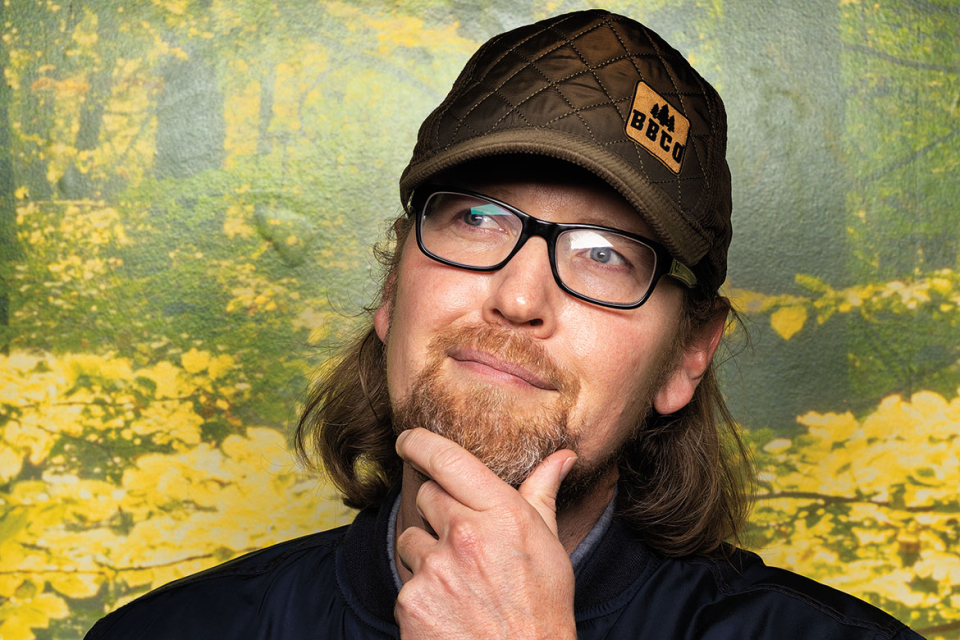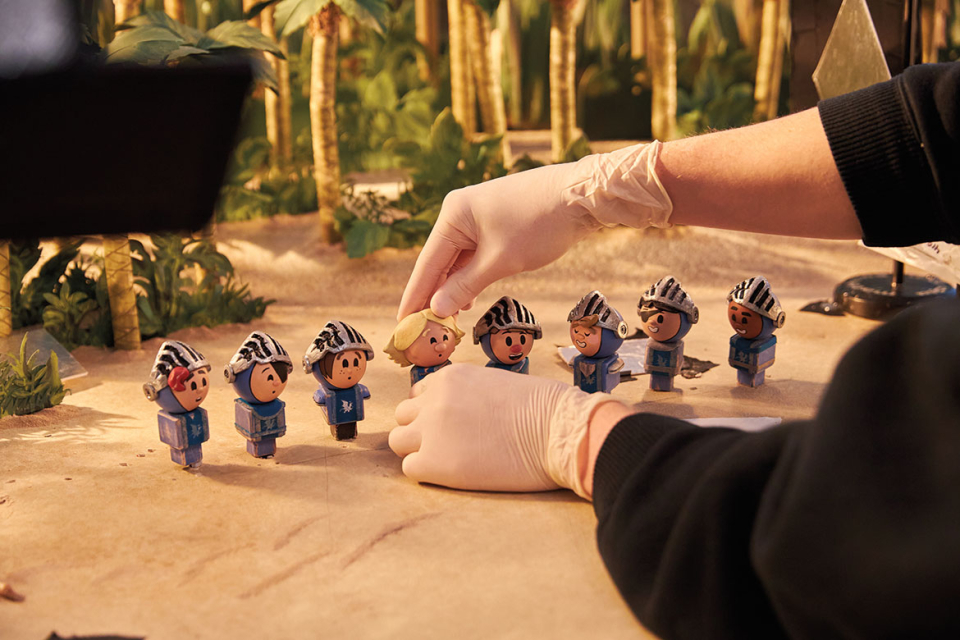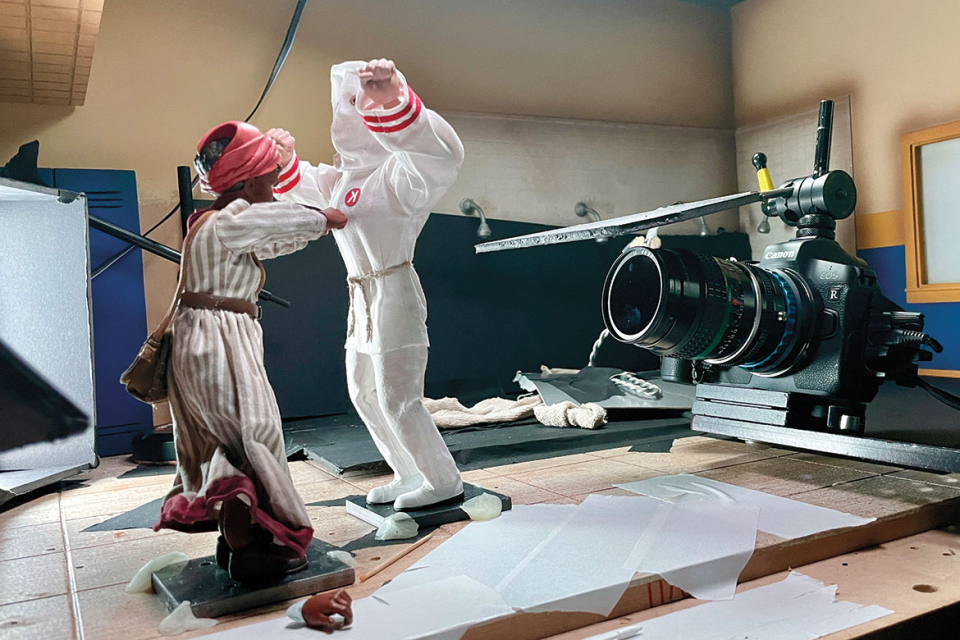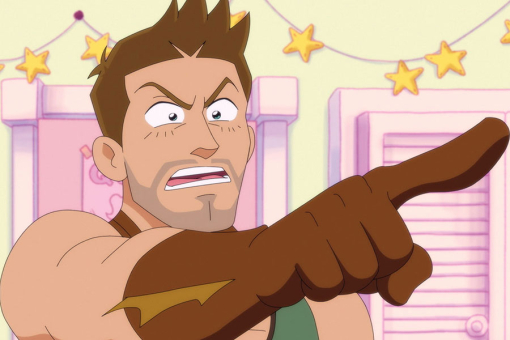If you're a fan of stop-motion, the name Stoopid Buddy Stoodios is likely to bring a smile to your face.
The animation house is such a familiar fixture that it's hard to believe it's only been a decade since Seth Green, Matthew Senreich, John Harvatine IV and Eric Towner formed the Burbank, California–based outfit, best known for producing Adult Swim's Robot Chicken. The series has won the Emmy for outstanding short-form animated program three times, along with eleven other nominations in that category.
Now, two years past the Covid-enforced slowdown of early 2020, the studio is humming with a colorful array of projects. In addition to producing buzzy animated shows such as Crossing Swords (Hulu), Ultra City Smiths (AMC), Santa Inc. (HBO Max) and Alabama Jackson (Adult Swim), Stoopid Buddy has ventured into new territories.
For example, the imaginative costumes on Fox's The Masked Singer are created by the studio's brilliant artisans. The studio has also launched Dominion X, an NFT-based stop-motion property created by electronic dance music producer Steve Aoki. Upcoming projects include a Disney+ musical series from Suburgatory creator Emily Kapnek and a zany stop-motion holiday special for Fox.
"We haven't told anyone else, but we've also taken over all the animation for Spider-Man: Across the Spider-Verse and the upcoming Avatar sequels," jokes Green, the high-energy actor-writer-producer known for movies such as Radio Days, the Austin Powers franchise and The Italian Job as well as series including Buffy the Vampire Slayer. He's also voiced Chris Griffin on Family Guy over the past few decades.
Green and Senreich first met in the late 1990s, when Senreich was editorial director of Wizard magazine. Their friendship led them to form the production company Stoopid Monkey in 2005 and create Robot Chicken, which recently completed shooting its eleventh season for Adult Swim. They launched the studio so they could create animation their own way.
"Harvatine and Eric reached out to partner with us so we could create this super studio that we have now," Senreich says. "Their full-service animation company was called Buddy Systems, so that's how we got our lovely name."
Greater creative control was key, as Green explains: "All of us had worked in different parts of this business, and when you're working on the creative side, you're always thinking about how to make it more fun or for less money — or how to actually get everything done the way you want to. So, our goal was to create a space where we could manufacture our own ideas, and have more creative innovation and a happy workplace. We didn't want to try to compete with Disney or DreamWorks. We wanted to provide all the animation services organically."
While Stoopid Buddy is often associated with Robot Chicken — which pokes fun at nerd-culture favorites like Star Wars, The Lord of the Rings, Harry Potter and Marvel and DC superheroes — it has also worked on projects that incorporate 2D or CG animation.
"We've always used different formats," Green says. "We often let the project dictate the style. We try to find the right aesthetic design for any given work — whether it's combining live-action with stop-motion or adding animated visual effects or shooting 2D with live backgrounds. It's about making the content in the best possible way."
The early months of the pandemic were tough on their stop-motion projects, the studio principals say, but they soon established health and safety protocols to keep productions running. "Other forms of animation production skyrocketed because of the pandemic," Senreich points out. "But because stop-motion requires in-person participation, it made it difficult for us. We had to find ways to maintain the productions — we wanted to keep people employed."
They sought to make all of their collaborators comfortable during that challenging time. "There was really no playbook," Senreich says. "So, we were proactive in talking to the other studios to find out how to do this safely. We were working with Marvel at the time, and [with their cooperation] we completed the work and kept everyone employed as much as we could."
Looking further back, Senreich recalls that in the early days of Stoopid Buddy, he and his partners didn't know much about the business of running an animation studio. "Back then, we were thinking, well, how hard can it actually be?" he says. "We thought, let's have a creative and safe space for people to explore different things in animation. Let's form a studio that we as animators would want to work at. So the studio culture was always a big part of our plan — along with promoting innovation and exploring different techniques."

They couldn't guess at the time the future parameters of the industry.
"If anyone had told Seth and me when we started doing Robot Chicken that animation would be as popular as it is today, we would've never believed them," Senreich says.
"Our show was one of the first stop-motion projects to come out after MTV's Celebrity Deathmatch. When we were doing the early webisodes, all the artists we hired had either worked on that show or [Fox's Will Vinton show] The PJs. Today, there are so many stop-motion shows and movies in various stages of development and production. It's wild to see the art form blossom and have people coming straight out of college to pursue a career in stop-motion animation."
For Green, Robot Chicken was a chance to pay homage to an art form he had admired from an early age.
"I grew up watching all kinds of animated shows and movies," he says. "When I was nine, I got to be in a Lemon Joy commercial that had a stop-motion, anthropomorphic lemon telling us how to clean our dishes. Years later, I came across these puppets that had been used for the opening of Pee-wee's Playhouse, including this small, decayed, crumbling foam puppet that kind of looked like Pee-wee. I had watched the show's opening hundreds of times, and I realized what a neat magic trick it was to make that puppet look so beautiful and alive on camera."
Pee-wee's Playhouse ended its four-season run back in 1990. Now it's been fifteen years since a mad scientist found a road-killed chicken and turned it into a cyborg. How does Green explain the enduring appeal of Robot Chicken?
"We get to make jokes about iconic pop-culture figures, using the shortcut of the audience's recognition of a particular toy they might have played with," he says. "So you get to force a lot of ideas into something almost as elegantly as an emoji. You have a real subject photographed with cinematic technology, and it is shadowed and has texture and weight. And if the animator is good, they can really bring it to life with its own identity. That's the magic that is almost indescribable."
Green has provided voices for many Robot Chicken characters over the years, and he's been Emmy-nominated five times for his voice work on the show. High-profile celebs also regularly lend their voices, including Patrick Stewart, Scarlett Johansson, Sam Elliott, Chris Evans and Bryan Cranston.
Cranston voiced his Breaking Bad character, Walter White, on the show, as well as Gandalf the Wizard and the Joker. He also voiced the lead character — and was an executive producer of — the Stoopid Buddy comedy SuperMansion. Of the Stoopid partners, he quips by email: "They formed this great animation company because they are truly good buddies, and they are all profoundly stoopid. They also happen to be supremely talented and hold themselves to a high standard to execute solid storytelling, with compelling characters and dynamic stop-motion animation. Their attention to every detail was very impressive to me. They are genuinely funny guys, and their collective congeniality was contagious — not like a Covid contagion, just the old-fashioned kind."
Adult Swim president Michael Ouweleen agrees. "Stoopid Buddy is the definition of irrepressible. The pace and density of ideas within any given episode of Robot Chicken is exactly how they are as people and a studio. Every conversation with the team eventually falls into a rabbit-hole, adoring discussion of some corner of pop culture. I now know to pad my time with them, so I can go there with them on any given call."
Harvatine, who cocreated the medieval fantasy spoof Crossing Swords with frequent collaborator Tom Root, says working on the show with tactile peg-toy characters has been a big highlight of his recent years.
"We thought a lot about the texture and look of the material before we came up with the characters," he notes. "It's a show about all the imperfections, the textures, the chipped paint, the wood details — all the organic stuff that we care about. I really love being able to see all the fingerprints and to witness how everything is made every step of the way. That's why when we were working remotely, and everything was done with Zoom, it drove me crazy. I was so happy when it was safe to start touching things again and interact with people in person."
One of Stoopid Buddy's most recent creations is Alabama Jackson, a time-traveling show created and voiced by Donald Faison (Scrubs, Clueless). Inspired loosely by the Indiana Jones movies, the stop-motion series follows an African-American archeologist who joins forces with Harriet Tubman (Wanda Sykes) to save Black history from the likes of Woodrow Wilson (Green) and his evil henchmen. Faison came up with the idea for the show at a San Diego Comic-Con panel, and the Stoopid Buddy team decided to greenlight it.
"We've worked with Donald Faison as a voice talent several times on Robot Chicken, and his curiosity for animation has always been a significant asset," Senreich says. "During the second season of Robot Chicken, he interned and studied the craft. He's even taken our stop-motion class multiple times. His passion for the craft is as genuine as his passion for Black history. When he mentioned an idea a few years ago about bringing Black history to general audiences in an entertaining way, we jumped at the opportunity to help fulfill his vision. He's such a passionate artist and helping him realize his dream in stop motion was incredibly exciting."
While the rules of modern comedy are still being rewritten for a new socially aware era, Green says Robot Chicken and the studio's other shows have always played with a kinder, gentler humor. "It's true that not everyone appreciates the same kind of humor," he allows. "But we believe in the obligation not to intentionally promote hateful philosophies. All the comedy that we make is meant to feel universally accessible. It's not meant to divide, and it always comes from a place of love."
Adds Senreich: "It's all about getting everyone in the room and just trying to make friends laugh!"
This article originally appeared in emmy magazine issue #7, 2022, under the title, "Buddy Up!"

















